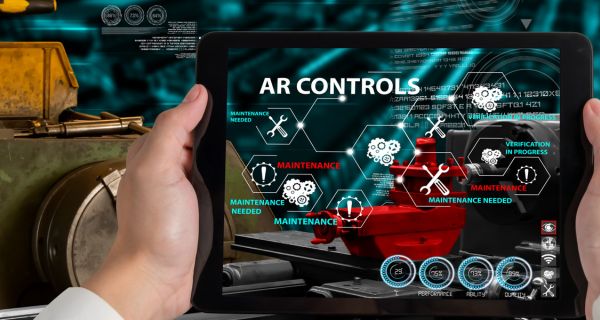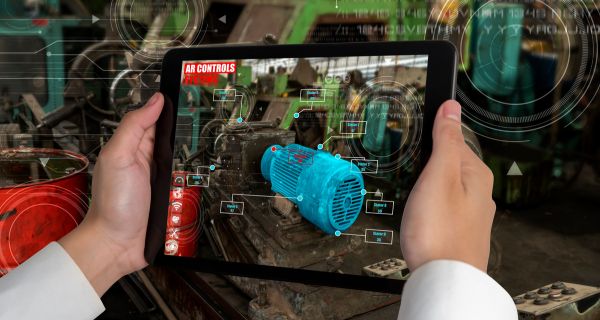Artificial intelligence (AI) creates intelligent systems that can reason, learn, and act independently. Augmented reality (AR) is a technology that allows users to superimpose digital content onto the physical world. AR, AI, and other cutting-edge technologies are often used to create more immersive and interactive experiences. For example, an AI-powered virtual assistant could provide users with information and assistance in an AR environment. Similarly, an AR system could display data and visualizations generated by an AI algorithm.
Artificial intelligence and augmented reality can be used together to create more immersive and interactive experiences, but they serve different purposes. AI is primarily focused on automating tasks and making them more efficient. In contrast, AR focuses on enhancing how we interact with the world by overlaying digital content onto the physical environment.
AI in AR

There are many examples of artificial intelligence in augmented reality (AR) applications. Some of them include:
- Personal assistants: AI-powered virtual assistants could provide users with information and assistance in an AR environment.
- Data visualization: AR could be used to display data and visualizations generated by AI algorithms, providing a more immersive and interactive way to understand complex information.
- Object recognition: AI could enable AR applications to recognize and track objects in the physical world, allowing for more interactive and contextual experiences.
- Natural language processing: AI could enable AR applications to understand and respond to voice commands, allowing for more natural and intuitive interactions with digital content.
- Predictive modeling: AI could predict the physical world, allowing AR applications to respond and adapt in real-time.
AR & AI in improving classroom education
One of the most promising applications of AI with AR is in the education sector. By using AR technology, students can interact with virtual models and simulations in real time, allowing them to gain a deeper understanding of complex concepts and theories. For example, a biology student could use AR to visualize the inner workings of a cell or the protein structure, or a student studying history could interact with virtual reenactments of historical events.
AR & AI in healthcare
Artificial Intelligence and Augmented Reality technologies can improve patient care and treatment outcomes in the healthcare industry. For example, doctors could use AR technology and Artificial Intelligence software to visualize and analyze medical scans and images in real-time, allowing for more accurate diagnoses and treatment plans. In addition, AR technology could assist with surgeries, providing doctors with real-time guidance and information during procedures.
AR & AI in retail and shopping
The retail industry is another area where AI and AR could significantly impact. By using AR technology, retailers can create immersive and interactive shopping experiences for customers. For example, customers could use AR applications to try on virtual clothes or accessories or to visualize how furniture or other items would look in their homes before making a purchase. In addition, retailers could use AI algorithms to analyze customer data and preferences to create personalized recommendations and offers.
AR & AI in defense
The military and defense sector is also exploring the potential of AI and AR technologies. By using AR applications, soldiers could access real-time information and guidance during missions, allowing them to make more informed decisions. In addition, AI algorithms could be used to analyze and interpret data from various sources, providing commanders with valuable insights and intelligence.
Advantages and perceived disadvantages of AR and AI
Here are some potential advantages and disadvantages of artificial intelligence (AI) and augmented reality (AR):
Advantages of AI:
- Improved efficiency: AI can automate tasks and make them more efficient, freeing humans to focus on higher-level work.
- Enhanced decision-making: AI can analyze large amounts of data and provide insights and recommendations to help humans make better decisions.
- Greater accuracy: AI can reduce the risk of human error and improve the accuracy of tasks such as data entry and analysis.
Disadvantages of AI:
- Job displacement: AI can automate tasks previously performed by humans, sometimes leading to job displacement.
- Bias: AI systems can exhibit bias if the data used to train them is biased.
- Lack of transparency: AI systems can be challenging to understand and interpret, making it difficult to know how they arrived at a particular decision or recommendation.
Advantages of AR:
- Enhanced learning: AR can create more immersive and interactive learning experiences, making it easier for users to understand and retain information.
- Improved efficiency: AR can provide real-time guidance and assistance to workers, improving their efficiency and accuracy.
- Enhanced entertainment: AR can create more immersive and interactive entertainment experiences.
Disadvantages of AR:
- Cost: AR development can be time-consuming and costly with a traditional approach.
- Limited adoption: AR technology is still in the early stages of adoption and may not be widely available or supported.
- Distraction: AR technology has the potential to be distracting and may not be suitable for all environments.
Overall, the combination of AI and AR has the potential to create more immersive and interactive experiences that can enhance a wide range of applications, including education, entertainment, and industry.
Privacy concerns with AR & AI and how is the industry addressing them?
While the potential benefits of AI and AR technologies are vast, some potential concerns and challenges need to be addressed. One major concern is the issue of privacy and data security. As AI and AR technologies rely on the collection and analysis of large amounts of data, there is a risk that personal information could be compromised or misused. To address this issue, solid safeguards and regulations must be implemented to protect personal data.
Another concern is the potential for AI and AR technologies to create new forms of inequality. As these technologies become more widespread and sophisticated, there is a risk that certain groups or individuals could be left behind or disadvantaged if they do not have access to the necessary resources or skills. To address this issue, it is essential to ensure that these technologies are accessible and inclusive and that efforts are made to educate and train individuals in their use.
Key Takeaways
Despite these challenges, the potential benefits of AI and AR technologies are too great to ignore. By embracing these technologies and working to address the concerns and challenges they present, we can create a future where these technologies enhance our lives and improve the world around us. If you are considering using an intelligent, cutting-edge AR development platform, try out PlugXR’s forever-free AR platform where anyone without technical expertise can build AR apps, and publish and maintain them on their own.
FAQs on AI
What is artificial intelligence?
Ans: AI is a computer science and engineering field focused on creating intelligent agents and systems that can reason, learn, and act independently.
How does artificial intelligence work?
Ans: AI algorithms allow systems to learn from data and experience, making decisions and taking actions without direct human input. There are various types of AI, including rule-based systems, decision trees, and machine learning algorithms such as neural networks.
What are some common applications of artificial intelligence?
Ans: AI has many potential applications, including image and speech recognition, natural language processing, and decision-making. It is also used in various industries, including healthcare, finance, and transportation.
Are there any potential drawbacks to artificial intelligence?
Ans: Some potential drawbacks to AI include job displacement, bias in decision-making, and a need for more transparency in how systems arrive at decisions. AI systems must be developed and used ethically and responsibly to mitigate these risks.
FAQs on AR
What is augmented reality?
Ans: AR technology allows users to superimpose digital content onto the physical world. This can be done through smartphones, tablets, and specialized AR headsets.
How does augmented reality work?
Ans: AR systems use a combination of hardware and software to track the user’s environment and display digital content in real time. This content is typically overlaid with the user’s view of the physical world, creating an augmented reality experience.
What are some common applications of augmented reality?
Ans: AR has many potential applications. In education, AR can create immersive learning experiences. In entertainment, AR can enhance video games and other forms of media. In industry, AR can provide real-time guidance and assistance to workers, improving efficiency and accuracy.
Are there any potential drawbacks to augmented reality?
Ans: Some potential drawbacks to AR include cost, limited adoption, and the potential for distraction. AR technology is still in the early stages of adoption and may not be widely available or supported. Additionally, AR experiences have the potential to be distracting and may not be suitable for all environments.

